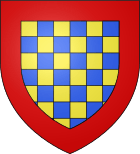House of Dreux
| House of Dreux | |
|---|---|
 Arms of the House of Dreux | |
| Country |
|
| Parent house | Capetian Dynasty |
| Titles | |
| Founded | 1137 |
| Founder | Robert I, Count of Dreux |
| Final ruler | Anne, Duchess of Brittany |
| Dissolution | 1514 |
| Ethnicity | French, Breton |
| Cadet branches |
|
The House of Dreux was a cadet branch of the Capetian dynasty. It was founded by Robert I, Count of Dreux, a son of Louis VI of France, who was given the County of Dreux as his appanage.
The Counts of Dreux were relatively minor nobles in France. The comital line became extinct in 1345. The family would have faded into obscurity with their Courtenay cousins if not for Philip Augustus. In 1212 the French king needed an obedient vassal to marry Alix, Duchess of Brittany. He turned to his cousin Peter, a younger son of the Count of Dreux. Peter's marriage to the heiress of Brittany placed the House of Dreux in one of the most important fiefs of France. Early dukes of Brittany descended from Peter used a canton ermine to mark them as cadets of the House of Dreux. Sometime in 1316, John III, Duke of Brittany adopted the plain ermine as the arms of the Duchy of Brittany.
At the death of John III in 1341, the succession to the duchy was contested by the duke's niece, Joan of Penthièvre, daughter of his full-brother, and John of Montfort, the duke's younger half-brother. Females had traditionally been able to succeed as duchesses. Montfort claimed that when Brittany became a peerage in 1297, the succession law of the suzerain kingdom (i.e., France and its Salic law) should apply (Note that this did not occur in the counties of Artois and Anjou, the two other fiefs raised to peerages in 1297). Joan had married Charles of Blois, a nephew of King Philip VI, who supported them. England supported the Montforts. It was ironic that the French and English kings supported the claimants opposite to the principle of their own claims to the French crown. Had the French won the House of Dreux would have been replaced by the House of Blois, a non-Capetian family, in the Duchy of Brittany. In the end, the Montforts won, but had to acknowledge the suzerainty of the King of France.
In the Treaty of Guérande, which ended the War of the Breton Succession, the Duchy of Brittany was made hereditary in the males of Montfort, after which it would pass to the males of Blois-Penthièvre. But in 1420 the Penthièvre family imprisoned the duke in an attempt to regain Brittany. They failed, and this event was said to be the reason why at the death of last male duke, Francis II of Brittany, the duchy simply passed to his daughter, Anne of Brittany.